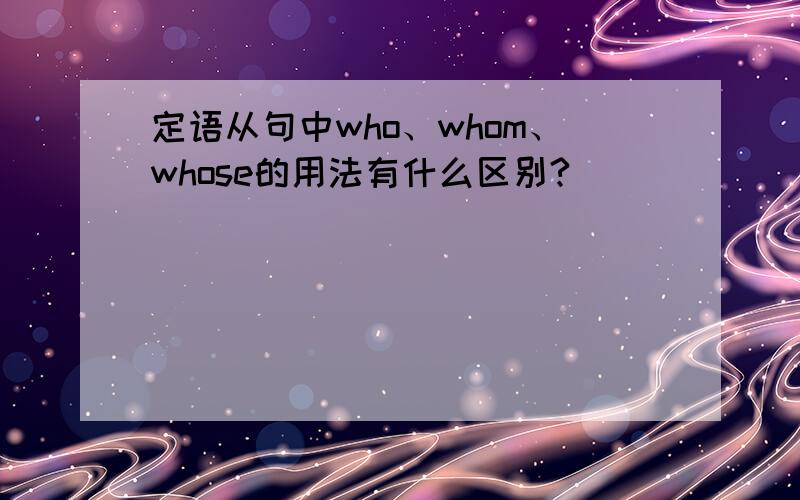定语从句中who、whom、whose的用法有什么区别?
来源:学生作业帮助网 编辑:作业帮 时间:2024/04/19 07:28:52

定语从句中who、whom、whose的用法有什么区别?
定语从句中who、whom、whose的用法有什么区别?
定语从句中who、whom、whose的用法有什么区别?
who 在定从中作主语,whom做宾语,whose作定语
who是指人!whom是指哪个人的!whose是指具体哪个人的东西的!
用来说明主句中某一名词或代词(有时也可说明整个主句或主句中一部分)而起定语作用的句子叫作定语从句。
一.词引导的定语从句
1. 关系代词用来指代先行词是人或物的名词或代词
句子成分 用于限制从句或非限制性从句 只用于限制性从句
代替人 代替物 代替人或物
主语 Who which ...
全部展开
用来说明主句中某一名词或代词(有时也可说明整个主句或主句中一部分)而起定语作用的句子叫作定语从句。
一.词引导的定语从句
1. 关系代词用来指代先行词是人或物的名词或代词
句子成分 用于限制从句或非限制性从句 只用于限制性从句
代替人 代替物 代替人或物
主语 Who which that
主语 Whom which that
宾语 Whose(=of whom) whose(=of which)
例1:This is the detective who came from London.
例2:The book which I am reading is written by Tomas Hardy.
例3:The desk whose leg is broken is very old.
例4:This is the room that Shakespeare was born in.
2.关系代词的用法
(1) 如果先行词是all, much, anything, something, nothing, everything, little, none等不定代词,关系代词一般只用that,不用which。例如:
All the people that are present burst into tears.
(2) 如果先等词被形容词最高级以及first, last, any, only, few, mush, no, some, very等词修饰,关系代词常用that,不用which, who,或whom。例如:
(3) 非限制性定语从句中,不能用关系代词that,作宾语用的关系代词也不能省略。例如:
There are about seven million people taking part in the election, most of whom、are well educated.
(4) which还有一种特殊用法,它可以引导从句修饰前面的整个主句,代替主句所表示的整体概念或部分概念。在这种从句中,which可以作主语,也可以作宾语或表语,多数情况下意思是与and this 相似,并可以指人。例如:
He succeeded in the competition, which made his parents very happy.
(5) that可指人或物,在从句中作表语,(指人作主语时多用who)仅用于限制性定语从句中。
(6) which可作表语,既可指人,以可指物。指人时,一般指从事某种职业或是有种特征.品性或才能的人。Which引导的定语从句可以限制性的,也可以是非限制性的。
(7) 如果作先作词的集体名词着眼于集体的整体,关系代词用which;若是指集体中的各个成员,则用who。
(8) 先行词有两个,一个指人,一个指物,关系代词应该用that。例如:
The boy and the dog that are in the picture are very lovely.
(9) 如果先行词是anyone, anybody, everyone, everybody, someone, somebody,关系代词应该用 who 或whom,不用 which。例如:
Is there anyone here who will go with you?
3.“介词+关系代词“是一个普遍使用的结构
(1) “介词+关系代词“可以引导限制性定语从句,也可以引导非限制性定语从句。“介词+关系代词“结构中的介词可以是 in, on, about, from, for, with, to at, of, without 等,关系代词只可用whom或 which,不可用 that 。
(2) from where为“介词+关系副词“结构,但也可以引导定语从句。例如:
We stood at the top of the hill, from where we can see the town..
(3) 像listen to, look at, depend on, pay attention to, take care of等固定短语动词,在定语从句中一般不宜将介词与动词分开。例如:
This is the boy whom she has taken care of.
二.关系副词引导的定语从句
1.关系副词也可以引导定语从句
关系副词在从句中分别表示时间.地点或原因。关系副词when在从句中充当时间状语,where 充当地点状语,why充当原因状语。
2. that可引导定语从句表示时间.地点或原因
That有时可以代替关系副词 when, where 或者why引导定语从句表示时间.地点或原因,在 that引导的这种定语从句中,that也可以省去。
三.限制性定语从句与非限制性定语从句
1.二者差异比较
限制定语从句紧跟先行词,同先行词这间一般不加逗号,仅修饰先行词,可以由关系代词.关系副词或that来引导。非限制性定语从句仅作补充或说明,用逗号与主句隔开,既可修饰先行词,又可修饰整个主句,不可用that引导。
2.关系代词和关系副词的选择依据
(1) 弄清代替先行词的关系词在从句中作什么成分,作状语的应选用关系副词,作主语.宾语或表语的可选用关系代词。
3. 先行词与定语从句隔离
定语从句一般紧跟在先行词之后,但定语从句与先行词之间有时也会插入别的成分,构成先行词与定语从句的隔离。例如:
1) This is the article written by him that Is poke to you about..
2) He was the only person in this country who was invited
四.As在定语从句中的用法
1. 引导限制性定语从句和非限制性定语从句
(1)as多与such 或the same连用,可以代替先行词是人或物的名词。
(2)as 也可单独使用,引导非限制性定语从句,作用相当于which。例如:
The elephant’s nose is like a snake, as anybody can see.
(3)the same… that与 the same …as在意思上是不同的。
2.As引导的非限制性定语从句的位置
as引导的非限制性定语从句位置较灵活,可以位于主句前面.中间或后面,一般用逗号与主句隔开,但which所引导的非限制性定语从句只能放在主句之后。例如:
(1) As is expected, the England team won the football match.
(2) The earth runs around the sun, as is known by everyone.
满意请采纳。
收起